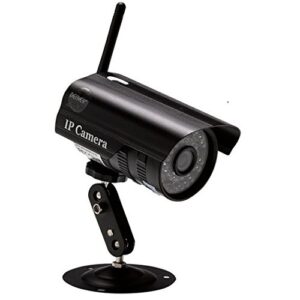How to Use NetCams and DiscoverVideo’s Spider Encoder to Record and Stream with RTSP
Network Cameras, a.k.a “NetCams”, can be a great way to capture live events or to monitor remote areas. Some of DiscoverVideo’s customers have outfitted sports arenas, lecture halls, doorways, and other locations with inexpensive NetCams. For me, I have NetCams around my home, and used them to discover what animals were treating my garden like a salad bar.
What if I wanted to live stream and record Woody the Woodchuck destroying my broccoli patch?

Most NetCams have pretty good encoders, but they have very limited network protocols. Many support motion JPEG (mjpeg) and the decent ones also support H264 with AAC audio. To be clear, we are talking about NetCams, not security camera subscription plans like Ring.com, Google Cloud Cam, or the like. These cameras are proprietary and only work with that vendor’s system. No, we are talking standard NetCams from the likes of Axis, Amcrest, and many others.
RTSP
Most NetCams support RTSP. Using RTSP you can view the stream using VLC or DVPlayer once you figure out the proper viewing URL. For example, the viewing URL for Axis would be something like “rtsp://192.168.1.100:554/axis-media/media.amp” and for an Amcrest Netcam it would be simply “rtsp://192.168.1.100:554” (use the camera’s IP address of course).
Cool, so now you can view your NetCam video using RTSP. But how can you send it to a server? How can you record it? How can you view it on your cell phone or in a browser?
DEVOS RTSP Pull
Using DEVOS server, you can simply enter the RTSP address in Super/Advanced/Pull and give it a stream name. This tells the server to “pull” the stream from the camera. Ta-Da! You now have the stream “inside” the server and can use it as you would any live stream and even include it in your Digital Signage lineup. Once the stream is “inside” the server, it is available as HLS, DASH, low delay stream, RTMP, even RTSP.
But a server cannot pull a stream that it cannot reach. And RTSP cannot “push” to a server.
If the NetCam is on your LAN and not exposed to the public Internet, and your server is on an outside network, the server cannot reach inside to pull the RTSP stream. That’s why RTMP push is valuable, since the encoder need not be exposed to the Internet. Push also allows you to use DHCP addresses, since the server does not care where the stream is coming from (provided it has the correct credentials).
So how can you use a NetCam and display it on DEVOS, Facebook, YouTube, Arcus, or other systems?
Spider Push/Pull
 The Spider Encoder has four video inputs. Each input can be a local HDMI audio/video source. But each input can be an external RTSP video source too. Simply enter the RTSP address of your NetCam, up to four of them. The Spider will receive and can even display your RTSP NetCams on a local TV monitor, and it will re-encode them and push them to your DEVOS, Facebook, YouTube, Arcus or other video streaming system. Spider can even mix your local HDMI video sources with RTSP NetCams in a quad view, cycle between them, record them, and more. From a NetCam point of view, you can use Spider to “convert” local RTSP to RTMP push, thus making NetCams available view viewing anywhere.
The Spider Encoder has four video inputs. Each input can be a local HDMI audio/video source. But each input can be an external RTSP video source too. Simply enter the RTSP address of your NetCam, up to four of them. The Spider will receive and can even display your RTSP NetCams on a local TV monitor, and it will re-encode them and push them to your DEVOS, Facebook, YouTube, Arcus or other video streaming system. Spider can even mix your local HDMI video sources with RTSP NetCams in a quad view, cycle between them, record them, and more. From a NetCam point of view, you can use Spider to “convert” local RTSP to RTMP push, thus making NetCams available view viewing anywhere.
You can still view your NetCam using a built-in web UI if the NetCam has one, you can still view using RTSP and VLC, DVPlayer, or similar, but thanks to Spider you can push your NetCam streams to a streaming server or service too.
Enjoy!
Rich






